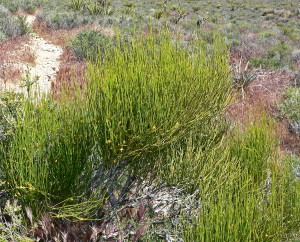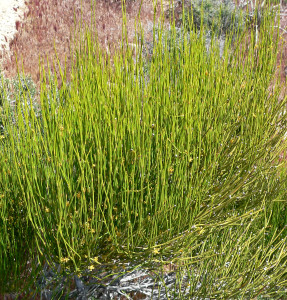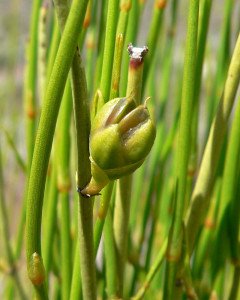Ephedra viridis, known by the common names green Mormon tea, green ephedra, and Indian tea, is a species of Ephedra. It is indigenous to the Western United States, where it is a member of varied scrub, woodland, desert, and open habitats. It grows at 900–2,300 metres (3,000–7,500 ft) elevations.
The Ephedra viridis shrub is woody below, topped with many dense clusters of erect bright green twigs. They may yellow somewhat with age.
Nodes along the twigs are marked by the tiny pairs of vestigial leaves, which start out reddish but soon dry to brown or black. Since the leaves are no longer functional, the stems are green and photosynthetic.
Male plants produce pollen cones at the nodes, each under a centimeter long with protruding yellowish sporangiophores. Female plants produce seed cones which are slightly larger and contain two seeds each.
Brigham Tea
(Ephedra viridis)
by Lindsay Wolsey
As with any plant, Ephedra viridis is known by a variety of common names. It received the name Brigham tea from the use of the plant for tea by the Mormon pioneers. It is also known as Mormon tea for the same reason. It is also known as joint fir, Squaw tea, tick tea, desert tea, miner’s tea, teamster’s tea, Mexican tea, popotillo.
Brigham Tea has been used medicinally for more than five thousand years. There have been no reported undesirable side effects when the plant is used in its wholesome state. Brigham tea has been used for a wide variety of ailments, including: asthma, hay fever, and other allergies for the first stages of a cold or influenza, arthritis, fluid retention, coughs, malarial and other fevers, headaches, rheumatism, syphilis, boils, acne, a digestive tonic, and many others. Brigham tea has been historically used by frontiersmen to treat venereal diseases, such as syphilis and gonorrhea.
Brigham tea lists ephedrine, pseudopherine, lucenin 2, phosphorus, resin, tannin, and vicenin 2 among its active constituents. The allopathic world extracts ephedrine and pseudopherine for use in pharmaceuticals. The pharmacological action of ephedrine is similar to adrenalin. Its pressor and vaso-constrictor activity is lower, but its action lasts longer. It stimulates respiration, and increases the depth of respiration. Ephedrine reinforces heart action and dilates the bronchi, especially during spasms-which is why it is used for bronchial asthma. Ephedrine stimulates the central nervous system, and is used for treating depression and narcolepsy. It is an expectorant, and is useful for acute sinusitis and hay fever. Using ephedrine extracted from a plant will result in side effects. Pseudoephedrine has a similar, but weaker effect that that of ephedrine. It has a stronger diuretic effect.
In five thousand years of use of the whole plant, not one negative side effect has been reported. In just a few short years of extracting ephedrine and pseedophedrine from the Ephreda plants, many negative side effects have been reported, including death! When the whole plant is used, all of the chemical constituents are present, including those that balance out the active constituents. When just one alkaloid is extracted, the alkaloid becomes a powerful pharmaceutical and very dangerous. Ephedrine should not be mixed with other stimulants, such as caffeine.
Dr. Christopher was teaching a class, and a grateful student brought in enough Brigham tea popsicles for the entire class. Dr. Christopher said that the popsicles were delicious! According to David Christopher, Brigham tea is one of the tastiest herbal teas there is, and he would like to try a popsicle made from Brigham tea and honey. The tea is very astringent.
Because true herbalists are not interested in extracting the active constituents of the plant, they use the whole plant in a traditional manner, i.e. teas, infusions, decoctions, tinctures, etc. Dr. Christopher used Brigham tea as a key ingredient in his Sinus, Hay fever and Allergy formula. Dr. Christopher also used Brigham tea in his Arthritis-Rheumatism formula, and the Sinus and Lung Combination.
http://www.herballegacy.com/Brigham_Tea.html
https://en.wikipedia.org/wiki/Ephedra_viridis





Leave a Reply